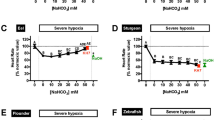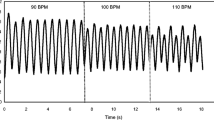Abstract.
The aim of the present study was to evaluate the effects of endothelin-1-elicited cardiovascular events on respiratory gas transfer in the freshwater rainbow trout (Oncorhynchus mykiss) and the marine dogfish (Squalus acanthias). In both species, endothelin-1 (666 pmol kg–1) caused a rapid (within 4 min) reduction (ca. 30–50 mmHg) in arterial blood partial pressure of O2. The effects of endothelin-1 on arterial blood partial pressure of CO2 were not synchronised with the changes in O2 partial pressure and the responses were markedly different in trout and dogfish. In trout, arterial CO2 partial pressure was increased transiently by ~1.0 mmHg but the onset of the response was delayed and occurred 12 min after endothelin-1 injection. In contrast, CO2 partial pressure remained more-or-less constant in dogfish after injection of endothelin-1 and was increased only slightly (~0.1 mmHg) after 60 min. Pre-treatment of trout with bovine carbonic anhydrase (5 mg ml–1) eliminated the increase in CO2 partial pressure that was normally observed after endothelin-1 injection. In both species, endothelin-1 injection caused a decrease in arterial blood pH that mirrored the changes in CO2 partial pressure. Endothelin-1 injection was associated with transient (trout) or persistent (dogfish) hyperventilation as indicated by pronounced increases in breathing frequency and amplitude. In trout, arterial blood pressure remained constant or was decreased slightly and was accompanied by a transient increase in systemic resistance, and a temporary reduction in cardiac output. The decrease in cardiac output was caused solely by a reduction in cardiac frequency; cardiac stroke volume was unaffected. In dogfish, arterial blood pressure was lowered by ~10 mmHg at 6–10 min after endothelin-1 injection but then was rapidly restored to pre-injection levels. The decrease in arterial blood pressure reflected an increase in branchial vascular resistance (as determined using in situ perfused gill preparations) that was accompanied by simultaneous decreases in systemic resistance and cardiac output. Cardiac frequency and stroke volume were reduced by endothelin-1 injection and thus both variables contributed to the changes in cardiac output. We conclude that the net consequences of endothelin-1 on arterial blood gases result from the opposing effects of reduced gill functional surface area (caused by vasoconstriction) and an increase in blood residence time within the gill (caused by decreased cardiac output.
Similar content being viewed by others
Author information
Authors and Affiliations
Additional information
Electronic Publication
Rights and permissions
About this article
Cite this article
Perry, .S., Montpetit, .C., McKendry, .J. et al. The effects of endothelin-1 on the cardiorespiratory physiology of the freshwater trout (Oncorhynchus mykiss) and the marine dogfish (Squalus acanthias). J Comp Physiol B 171, 623–633 (2001). https://doi.org/10.1007/s003600100213
Accepted:
Issue Date:
DOI: https://doi.org/10.1007/s003600100213




